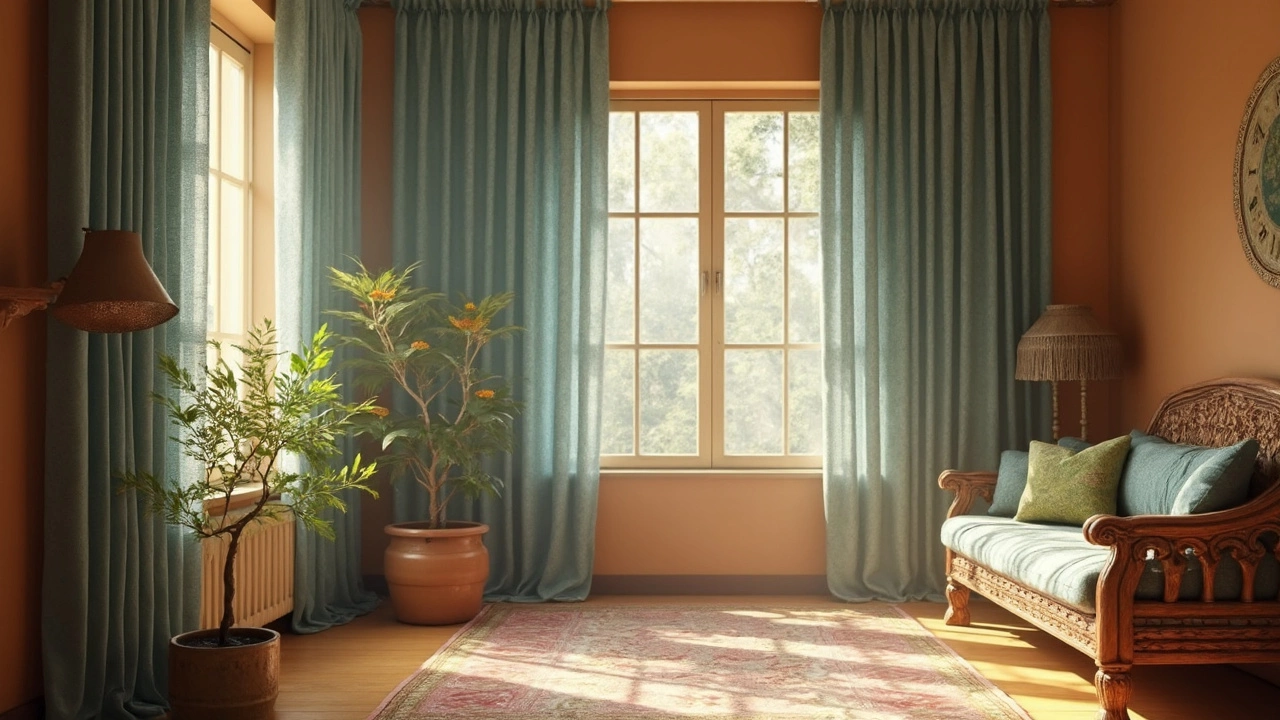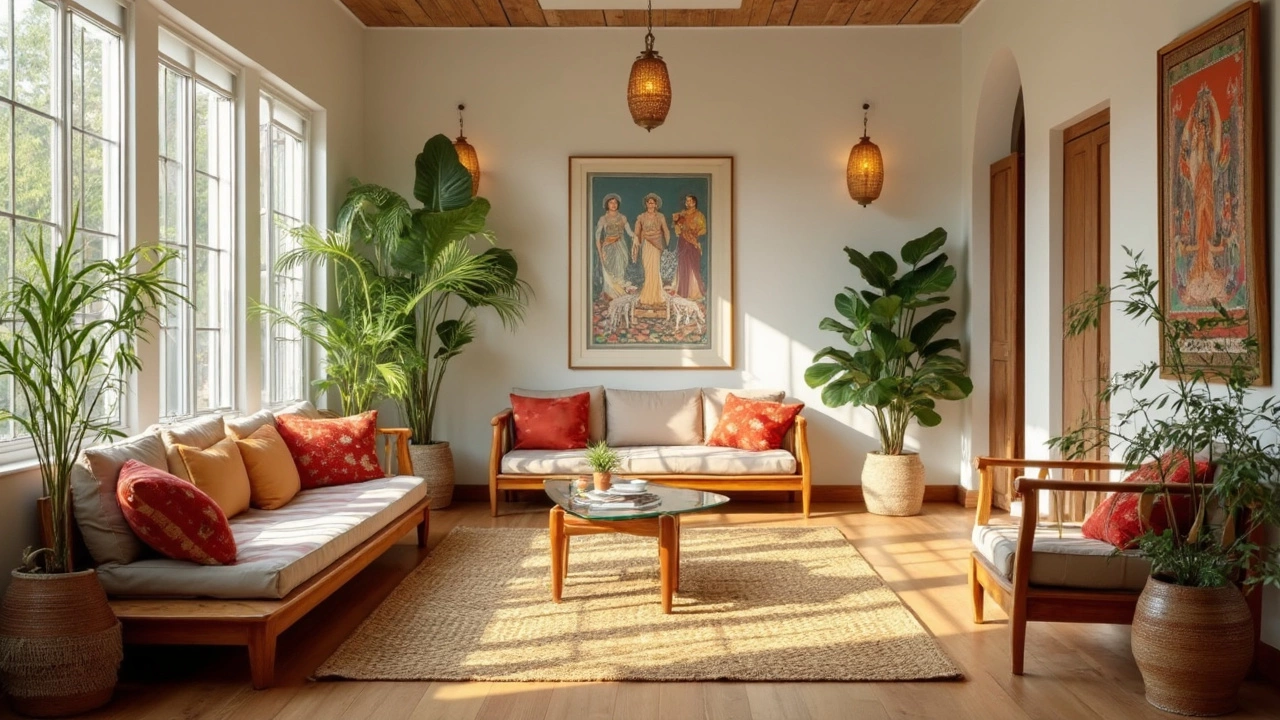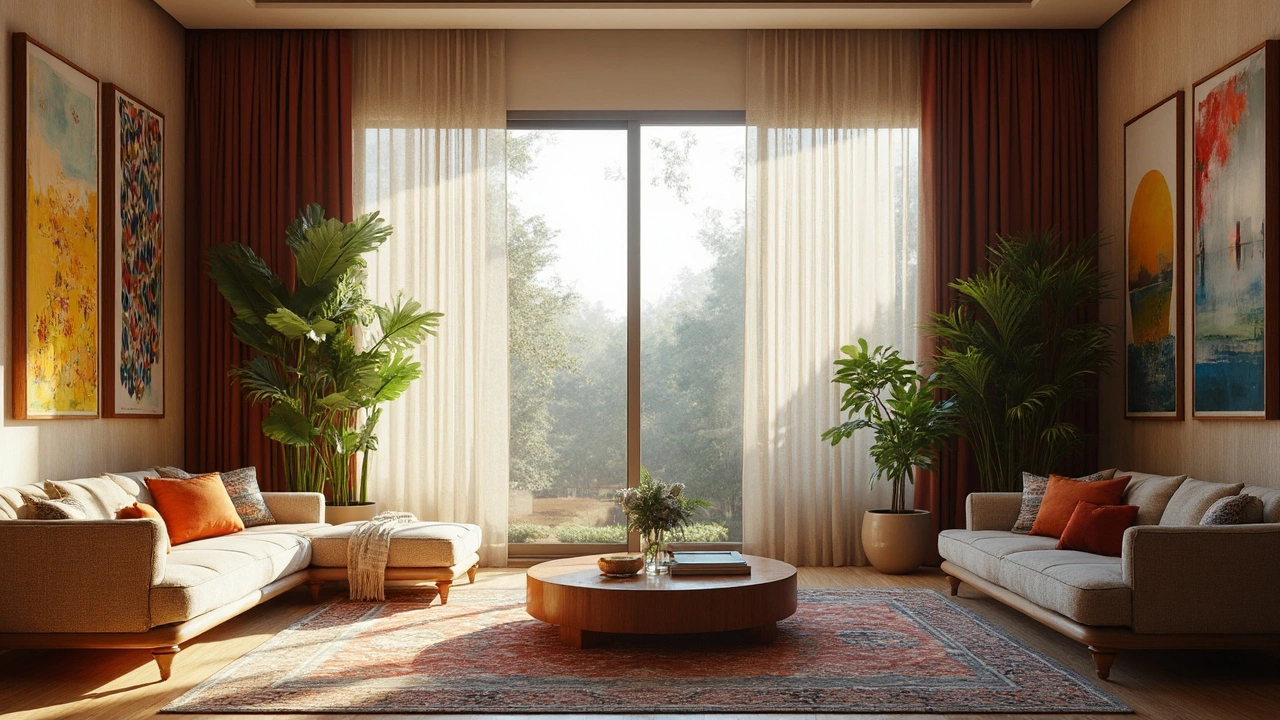Should Curtains Be Lighter or Darker Than Wall Color?

Color choice in home decor isn't just about picking a shade that appeals to you; it's a strategic decision that affects the mood and style of your entire space. Ever stood in a paint aisle, debating whether your curtains should be lighter or darker than your walls? You're not alone! This choice can make or break the ambiance of a room.
First off, think about light. Rooms bathed in natural light can often handle darker curtains. Dark curtains can create a cozy, intimate vibe—great for a bedroom or a relaxing living room. But if your space is more like a cave, lighter curtains might be the way to go. They reflect more light, making the room feel brighter and more open.
- Understanding Color Basics
- Impact of Natural Light
- Room Size Considerations
- Personal Style and Aesthetic
- Practical Tips for Choosing
Understanding Color Basics
So, you're ready to tackle the big question. Let's break down some color theory to help you figure out the best curtain-to-wall color combo.
The color wheel is your friend here. It shows you how colors relate to each other. Ever heard of complementary colors? They sit opposite each other on the wheel—like blue and orange. These create a high-contrast, vibrant look, which can make a room pop. But if you're after something more subtle, analogous colors (neighbors on the wheel, like green and yellow) might be your style.
Think about the undertones. Walls and curtains should either share similar undertones or contrast clearly for a balanced look. Mixing warm and cool undertones usually doesn’t work well, unless you're deliberately going for an eclectic style.
Warm vs. Cool Colors
Warm colors like reds, oranges, and yellows can make a space feel cozier and inviting—perfect for living rooms. In contrast, cool colors like blues and greens create a calming, spacious vibe, great for bedrooms or studios.
Monochromatic Schemes
If you love simplicity, a monochromatic scheme could work. Choose different shades of the same color for both walls and curtains. This can make a small room feel larger because there are no harsh contrasts breaking the space.
| Color Scheme | Best For |
|---|---|
| Complementary | High energy spaces |
| Analogous | Harmony and balance |
| Monochromatic | Small rooms |
Remember, no rule is set in stone. Your personal style and the mood you want to create are what's most important. This is your space, after all!
Impact of Natural Light
Natural light plays a massive role in deciding whether your curtains should be lighter or darker than the wall color. It can transform the appearance of colors within your home, sometimes even more dramatically than artificial lighting.
How Light Affects Colors
In brightly lit rooms, darker curtains can add depth and create contrast against lighter walls. They soak up the sun, preventing a space from feeling too washed out. This effect can make your space feel cozy and well-balanced, especially in large, open rooms.
On the flip side, spaces with limited natural light benefit from lighter curtains. Lighter curtains reflect more light, thereby giving an illusion of a bigger and brighter room. If your room already feels a bit dreary, opting for light-colored curtains could be a game-changer.
Specific Room Advice
The effect of natural light isn't just on the curtains themselves, but also how they harmonize with your walls. Here’s a quick guide to get you started:
- If your room faces south, you probably enjoy full sun most of the day, which means you have the flexibility to go for either light or dark curtains based on your style.
- East and west-facing rooms experience direct sunlight only part of the day, so choosing a curtain that balances early or late sun with midday shade is key.
- North-facing rooms receive the least amount of sunlight. Here, lighter curtains can work wonders to lift the mood and make the space seem more inviting.
Considering how light interacts with your space ensures your interior design is not only stylish but also functional. You'll find that pairing your curtains with the right wall color can dramatically influence the vibe of any room.

Room Size Considerations
When it comes to picking curtains, your room's size plays a big role in your decision. For small rooms, lighter curtains are often a great choice as they can make the space feel bigger and more open by reflecting more light. Opt for lighter shades to avoid a cramped feeling.
In contrast, if you've got a large room, you've got a bit more leeway. Darker curtains can add depth and a sense of coziness. They break up the vastness and make the space feel more inviting, especially against neutral or light-colored walls.
Ceiling Height Matters Too
Got low ceilings? Choose curtains that match the wall color, or go a shade lighter to create an illusion of height. If your ceilings are high, darker curtains can help anchor the room, making it appear more balanced.
More Than Just Size
Think about how space is used. For busy spaces like living rooms, **darker curtains** might hide stains better. In less-used spaces, lighter curtains that complement the wall color can highlight decor.
Whether you've got a cozy nook or a spacious living area, understanding the dynamics of your room's size will help you make the most out of your curtain choices. It's all about creating harmony between your space and your decor.
Personal Style and Aesthetic
When it comes to choosing curtains, your personal style shouldn’t take a backseat. Your home should reflect who you are, and curtain choices can play a big part in that expression. Whether you lean towards a modern vibe or have a soft spot for vintage elements, your curtain selection should align with your interior design vision.
Think about the existing decor in your room. If you have walls painted in vibrant colors or adorned with bold patterns, opting for curtain ideas that are more subdued or neutral can offer a nice balance and prevent sensory overload. But if your walls are a blank canvas, don't hold back— curtains in a daring hue or pattern can serve as a standout piece.
Consider Your Lifestyle
Practicality often guides aesthetic choices. If you've got young kids or pets, you might lean towards darker curtains which are more forgiving with stains and marks. On the other hand, lighter curtains can create an airy feel, perfect if you’re aiming for an open, serene environment.
"Curtains are a unique element in home decor; they can complete a room’s look or become the centerpiece," says Jane Greenwood, a renowned interior designer. "When chosen thoughtfully, they can elevate the entirety of a space."
Embracing home decor trends can also inspire your curtain choices. Earthy tones, for example, have made a comeback, bringing a sense of nature into the home. But always remember, trends should never overshadow your personality. A home that feels like you is the ultimate goal.

Practical Tips for Choosing
When picking out curtains, a few practical tips can make all the difference. Choosing between lighter or darker curtains than your wall is not just about style—it's about understanding how these choices affect your space. Let's break down some key points.
Consider Your Room's Purpose
Different rooms have different needs. For instance, in a bedroom, you might prefer darker curtain ideas for a soothing feel. In contrast, a home decor office might benefit from lighter curtains to keep you alert and energized.
Think About the Seasons
Changing curtains seasonally isn't just a trendy move. Lighter curtains in the summer can create an airy feel, while heavier, darker ones in winter can add warmth. A simple swap can refresh your room twice a year with minimal effort.
Match Your Style
Your curtains should reflect your style. If you’re about bold, go for a sharp contrast; a bright hue against a neutral wall or vice versa. For a more traditional look, aim for harmony by keeping curtains close in shade to your walls.
Trust the Experts
“Curtains have the power to transform a space instantly, both aesthetically and functionally.” — Laura Ashley Interiors
Tap into the wisdom of interior designers when you're stuck. Their insights help clarify what will turn your home from bland to grand.
- Consider how much sunlight the room gets.
- Think about how curtains will look both open and closed.
- Don't be afraid to layer different textures for a plush effect.
- Measure your windows accurately to avoid purchasing mistakes.
Remember, your home is your space to express yourself. Use these insights to choose curtains that aren't just functional, but also add a personal touch to every room.


